Irradiation Facilities of the Takasaki Advanced Radiation Research Institute
Abstract
:1. Introduction
2. Overview of the Facilities
2.1. TIARA
2.2. Electron Beam Irradiation Facility
2.3. Gamma-ray Irradiation Facilities
3. Cyclotron
3.1. AVF Cyclotron and Ion Sources
3.2. Beamlines
4. Cyclotron Technology Development
4.1. Magnetic Field Stabilization of the Cyclotron
4.2. Single-Pulse Beam Formation
4.3. Cocktail Beam Acceleration
5. Experimental Apparatus and Application for the Cyclotron
5.1. Large-Area Uniform Irradiation Apparatus
5.2. Microbeam Irradiation Apparatus
6. Electrostatic Accelerators
6.1. Three Electrostatic Acclerators and Their Ion Sources
6.2. Typical Beam Irradiation Apparatus
7. Ion-Microbeam System
7.1. Heavy-Ion Microbeam System
7.2. Light-Ion Microbeam System
7.3. Applications
7.3.1. Single Ion Hit
7.3.2. Micro Particle Induced X/Gamma-ray Emission
7.3.3. Proton Beam Writing
Author Contributions
Conflicts of Interest
References
- Arakawa, K.; Nakamura, Y.; Yokota, W.; Fukuda, M.; Nara, N.; Agematsu, T.; Okumura, S.; Ishibori, I.; Karasawa, T.; Tanaka, R.; et al. Construction and first year's operation of the JAERI AVF cyclotron. In Proceedings of the 13th International Conference on Cyclotrons and Their Applications, Vancouver, BC, Canada, 6–12 July 1992; Dutto, G., Craddock, M.K., Eds.; World Scientific: Singapore, 1992; pp. 119–122. [Google Scholar]
- Saitoh, Y.; Tajima, S.; Takada, I.; Mizuhashi, K.; Uno, S.; Ohkoshi, K.; Ishii, Y.; Kamiya, T.; Yotumoto, K.; Tanaka, R.; et al. TIARA electrostatic accelerators for multiple ion beam application. Nucl. Instrum. Methods Phys. Res. B 1994, 89, 23–26. [Google Scholar] [CrossRef]
- Koivisto, H.; Arje, J.; Nurmia, M. Metal ions from the volatile compounds method for the production of metal ion beams. Rev. Sci. Instrum. 1998, 69, 785–787. [Google Scholar] [CrossRef]
- Yoshida, K.; Nara, T.; Saitoh, Y.; Yokota, W. Stability study of all-permanent-magnet electron cyclotron resonance ion source. Rev. Sci. Instrum. 2010, 81, 02A312. [Google Scholar] [CrossRef] [PubMed]
- Kurashima, S.; Miyawaki, N.; Okumura, S.; Ishibori, I.; Nara, T.; Agematsu, T.; Yoshida, K.; Yokota, W.; Nakamura, Y.; Arakawa, K.; et al. Single-turn extraction from a K110 AVF cyclotron by flat-top acceleration. Rev. Sci. Instrum. 2009, 80, 033302. [Google Scholar] [CrossRef] [PubMed]
- Miyawaki, N.; Fukuda, M.; Kurashima, S.; Kashiwagi, H.; Okumura, S.; Arakawa, K.; Kamiya, T. Evaluation of phase bunching in the central region of a cyclotron by a radial probe with a plastic scintillator. Nucl. Instrum. Methods Phys. Res. A 2014, 767, 372–378. [Google Scholar] [CrossRef]
- Kashiwagi, H.; Miyawaki, N.; Kurashima, S.; Okumura, S. A transverse emittance and acceptance measurement system in a low-energy beam transport line. Rev. Sci. Instrum. 2014, 85, 02A735. [Google Scholar] [CrossRef] [PubMed]
- Okumura, S.; Arakawa, K.; Fukuda, M.; Nakamura, Y.; Yokota, W.; Ishimoto, T.; Kurashima, S.; Ishibori, I.; Nara, T.; Agematsu, T.; et al. Magnetic field stabilization by temperature control of an azimuthally varying field cyclotron magnet. Rev. Sci. Instrum. 2005, 76, 033301. [Google Scholar] [CrossRef]
- Kurashima, S.; Miyawaki, N.; Kashiwagi, H.; Okumura, S.; Taguchi, M.; Fukuda, M. Enhancement of beam pulse controllability for a single-pulse formation system of a cyclotron. Rev. Sci. Instrum. 2015, 86, 073311. [Google Scholar] [CrossRef] [PubMed]
- Kurashima, S.; Yuyama, T.; Miyawaki, N.; Kashiwagi, H.; Okumura, S.; Fukuda, M. Useful technique for analysis and control of the acceleration beam phase in the azimuthally varying field cyclotron. Rev. Sci. Instrum. 2010, 81, 033306. [Google Scholar] [CrossRef] [PubMed]
- Masuda, A.; Matsumoto, T.; Harano, H.; Tanimura, Y.; Shikaze, Y.; Yoshitomi, H.; Nishino, S.; Kurashima, S.; Hagiwara, M.; Unno, Y.; et al. Time-of-Flight Measurements for Low-Energy Components of 45-MeV Quasi-Monoenergetic High-Energy Neutron Field from 7Li(p,n) Reaction. IEEE Trans. Nucl. Sci. 2015, 62, 1295–1300. [Google Scholar] [CrossRef]
- McMahan, M.A. The Berkeley Accelerator Space Effects (BASE) Facility—A new mission for the 88-Inch Cyclotron at LBNL. Nucl. Instrum. Methods Phys. Res. B 2005, 241, 409–413. [Google Scholar] [CrossRef]
- Ziegler, J.F. Computer Code SRIM-2013. Available online: http://www.srim.org/ (accessed on 28 December 2016).
- Yuri, Y.; Ishizaka, T.; Yuyama, T.; Ishibori, I.; Okumura, S.; Yoshida, K. Formation of a large-area uniform ion beam using multipole magnets in the TIARA cyclotron. Nucl. Instrum. Methods Phys. Res. A 2011, 642, 10–17. [Google Scholar] [CrossRef]
- Funayama, T.; Wada, S.; Yokota, Y.; Fukamoto, K.; Sakashita, T.; Taguchi, M.; Kakizaki, T.; Hamada, N.; Suzuki, M.; Furusawa, Y.; et al. Heavy-Ion Microbeam System at JAEA-Takasaki for Microbeam Biology. J. Radiat. Res. 2008, 49, 71–82. [Google Scholar] [CrossRef] [PubMed]
- Oikawa, M.; Satoh, T.; Sakai, T.; Miyawaki, N.; Kashiwagi, H.; Kurashima, S.; Okumura, S.; Fukuda, M.; Yokota, W.; Kamiya, T. Focusing high-energy heavy ion microbeam system at the JAEA AVF cyclotron. Nucl. Instrum. Methods Phys. Res. B 2007, 260, 85–90. [Google Scholar] [CrossRef]
- Kurashima, S.; Yoshida, K.; Oikawa, M.; Satoh, T.; Miyawaki, N.; Yuyama, T.; Okumura, S.; Kashiwagi, H.; Ishibori, I.; Nara, T.; et al. Quick change of ion species of heavy-ion microbeam by cocktail beam acceleration technique with the JAEA AVF cyclotron. Nucl. Instrum. Methods Phys. Res. B 2009, 267, 2024–2027. [Google Scholar] [CrossRef]
- Saitoh, Y.; Chiba, A.; Narumi, K. Transmission of cluster ions through a tandem accelerator of several stripper gases. Rev. Sci. Instrum. 2009, 80, 106104. [Google Scholar] [CrossRef] [PubMed]
- Saitoh, Y.; Mizuhashi, K.; Tajima, S. Acceleration of cluster and molecular ions by TIARA 3 MV tandem accelerator. Nucl. Instrum. Methods Phys. Res. A 2000, 452, 61–66. [Google Scholar] [CrossRef]
- Chiba, A.; Usui, A.; Yamada, K. Novel Approach to Intensification and Stabilization of Negative Fullerene Ion Beam Using a Cesium Sputter Type Ion Source; JAEA-Review 2014-050; Japan Atomic Energy Agency: Ibaraki-ken, Japan, 2015; p. 169. Available online: http://jolissrch-inter.tokai-sc.jaea.go.jp/pdfdata/JAEA-Review-2014-050.pdf (accessed on 28 December 2016).
- Middleton, R. A versatile high intensity negative ion source. Nucl. Instrum. Methods Phys. Res. B 1983, 214, 139–150. [Google Scholar] [CrossRef]
- Girinius, R.; Anderson, L.W. Collisions, He+ ions with a Rb vapor target. Nucl. Instrum. Methods 1976, 137, 373–378. [Google Scholar] [CrossRef]
- Saitoh, Y.; Ohkoshi, K.; Arakawa, K. Development of 13 GHz Compact Electron Cyclotron Resonance Ion Source. Rev. Sci. Instrum. 2004, 75, 1502–1505. [Google Scholar] [CrossRef]
- Cookson, J.A. The production and use of a nuclear microprobe of ions at MeV energies. Nucl. Instrum. Methods 1979, 165, 477–508. [Google Scholar] [CrossRef]
- Legge, G.J.F. A history of ion microbeams. Nucl. Instrum. Methods Phys. Res. B 1997, 130, 9–19. [Google Scholar] [CrossRef]
- Brown, K.L.; Carey, D.C.; Iselin, C.; Rothacker, F. Transport, a Computer Program for Designing Charged Particle Beam Transport Systems; Yellow Report CERN 80-04; CERN: Geneva, Switzerland, 1980. [Google Scholar]
- Tajima, S.; Takada, I.; Mizuhashi, K.; Uno, S.; Okoshi, K.; Nakajima, Y.; Saito, Y.; Ishii, Y.; Kamiya, T. TIARA Electrostatic Accelerator Facility; JAERI-Tech-96-029; Japan Atomic Energy Research Institute: Ibaraki-ken, Japan, 1996. [Google Scholar]
- Price, W.E.; Coss, J.R. Single event phenomena: A summary. Nucl. Instrum. Methods Phys. Res. B 1989, 40, 1306–1309. [Google Scholar] [CrossRef]
- Grilj, V.; Skukan, N.; Pomorski, M.; Kada, W.; Iwamoto, N.; Kamiya, T.; Ohshima, T.; Jakšić, M. An ultra-thin diamond membrane as a transmission particle detector and vacuum window for external microbeams. Appl. Phys. Lett. 2013, 103, 243106. [Google Scholar] [CrossRef]
- Grilj, V.; Skukan, N.; Jakšić, M.; Kada, W.; Kamiya, T. Irradiation of thin diamond detectors and radiation hardness tests using MeV protons. Nucl. Instrum. Methods Phys. Res. B 2013, 306, 191–194. [Google Scholar] [CrossRef]
- Yamamoto, T.; Onoda, S.; Ohshima, T.; Teraji, T.; Watanabe, K.; Koizumi, S.; Umeda, T.; McGuinness, L.P.; Müller, C.; Naydenov, B.; et al. Isotopic identification of engineered nitrogen-vacancy spin qubits in ultrapure diamond. Phys. Rev. B 2014, 90, 81117. [Google Scholar] [CrossRef]
- Kamiya, T.; Suda, T.; Tanaka, R. Sub-micron microbeam apparatus for high resolution materials analyses. Nucl. Instrum. Methods Phys. Res. B 1996, 118, 447–450. [Google Scholar] [CrossRef]
- Ishii, K.; Sugimoto, A.; Tanaka, A.; Satoh, T.; Matsuyama, S.; Yamazaki, H.; Akama, C.; Amartivan, T.; Endoh, H.; Oishi, Y.; et al. Elemental analysis of cellular samples by in-air micro-PIXE. Nucl. Instrum. Methods Phys. Res. B 2001, 181, 448–453. [Google Scholar] [CrossRef]
- Shimizu, Y.; Dobashi, K.; Kusakabe, T.; Nagamine, T.; Oikawa, M.; Satoh, T.; Haga, J.; Ishii, Y.; Ohkubo, T.; Kamiya, T.; et al. In-air micro-particle induced X-ray emission analysis of asbestos and metals in lung tissue. Int. J. Immunopathol. Pharmacol. 2008, 21, 567–576. [Google Scholar] [CrossRef] [PubMed]
- Mima, K.; Gonzalez-Arrabal, R.; Azuma, H.; Yamazaki, A.; Okuda, C.; Ukyo, Y.; Sawada, H.; Fujita, K.; Kato, Y.; Perlado, J.M.; et al. Li distribution characterization in Li-ion batteries positive electrodes containing LixNi0.8Co0.15Al0.05O2 secondary particles (0.75 ⩽ x ⩽ 1.0). Nucl. Instrum. Methods Phys. Res. B 2012, 290, 79–84. [Google Scholar] [CrossRef] [Green Version]
- Van Kan, J.A.; Bettiol, A.A.; Watt, F. Proton beam writing of three-dimensional nanostructures in hydrogen silsesquioxane. Nano Lett. 2006, 6, 579–582. [Google Scholar] [CrossRef] [PubMed]
- Van Kan, J.A.; Shao, P.G.; Ansari, K.; Bettiol, A.A.; Osipowicz, T.; Watt, F. Proton beam writing: A tool for high-aspect ratio mask production. Microsyst. Technol. 2007, 13, 431–434. [Google Scholar] [CrossRef]
- Furuta, Y.; Uchiya, N.; Nishikawa, H.; Haga, J.; Sato, T.; Oikawa, M.; Ishii, Y.; Kamiya, T. Fabrication of three-dimensional structures of resist by proton beam writing. J. Vac. Sci. Technol. B 2007, 25, 2171–2174. [Google Scholar] [CrossRef]
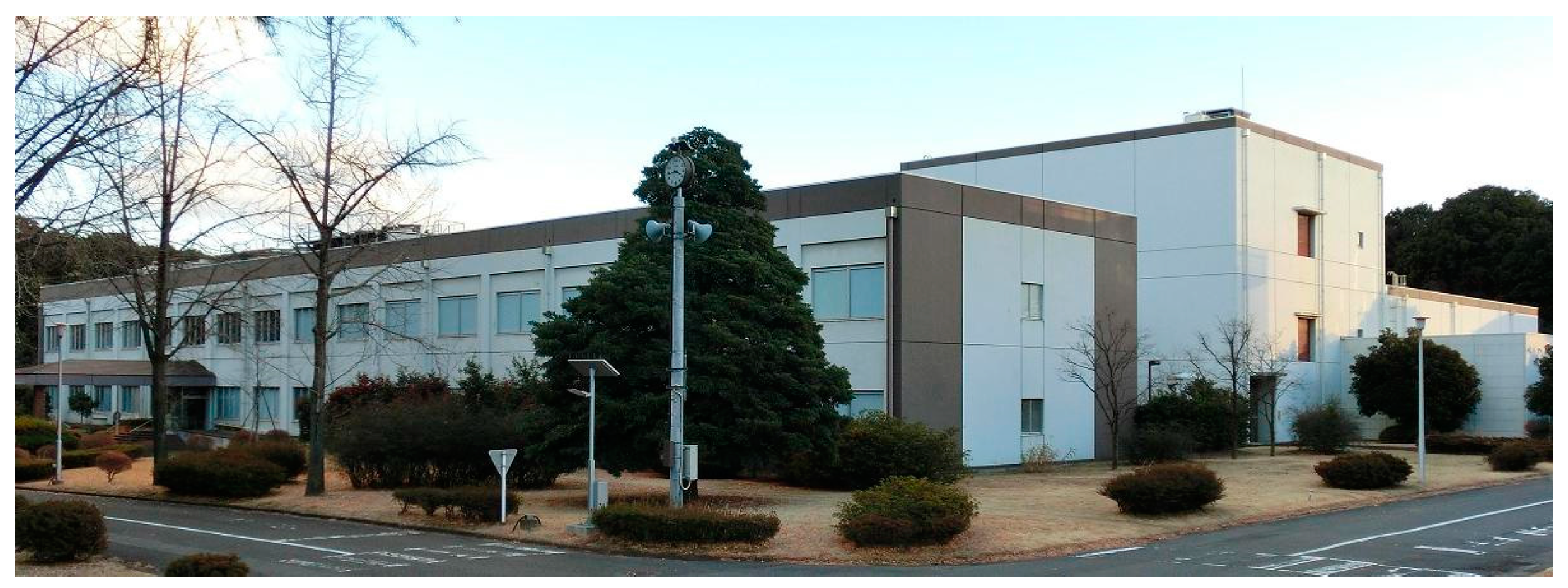
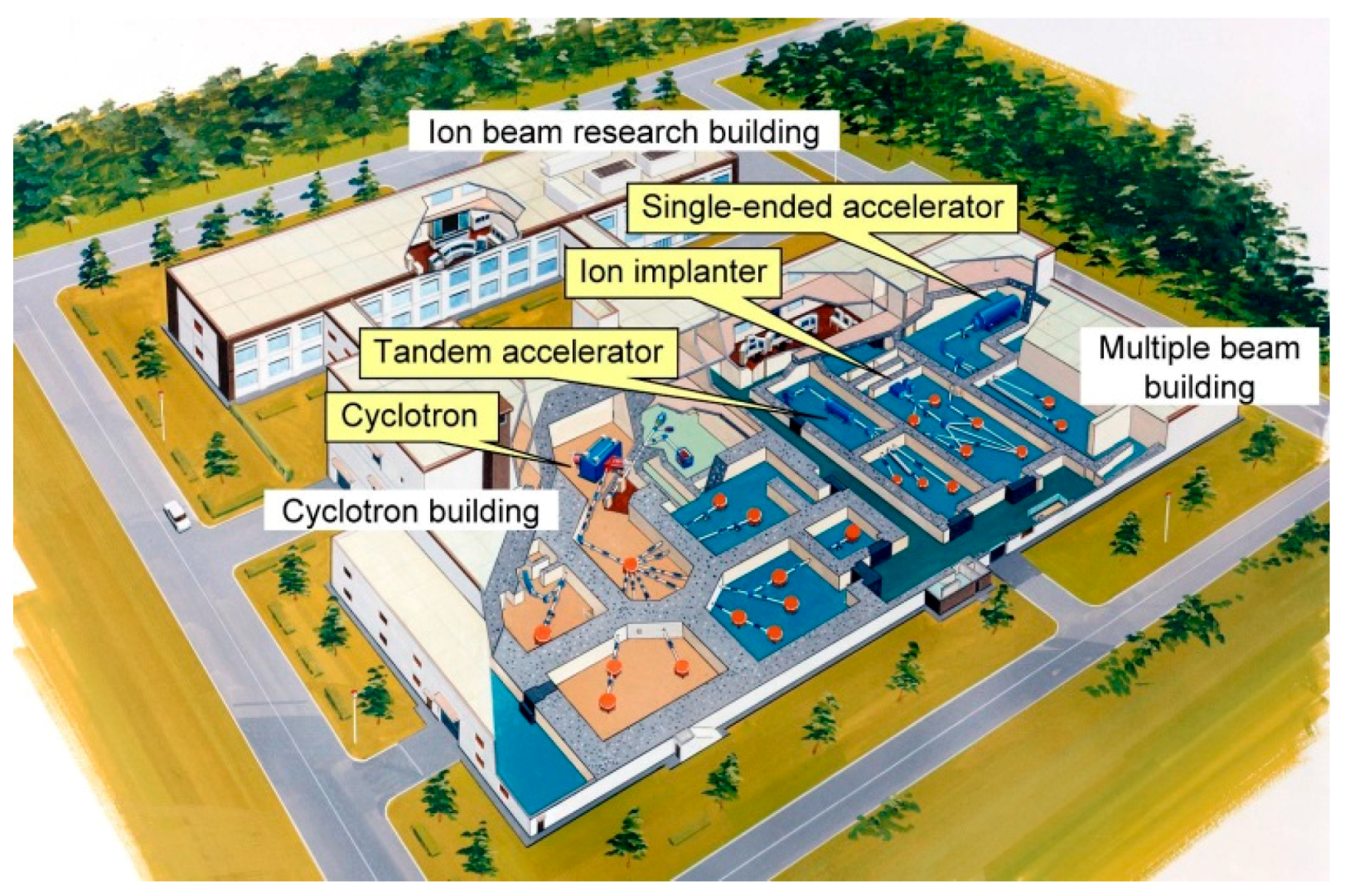
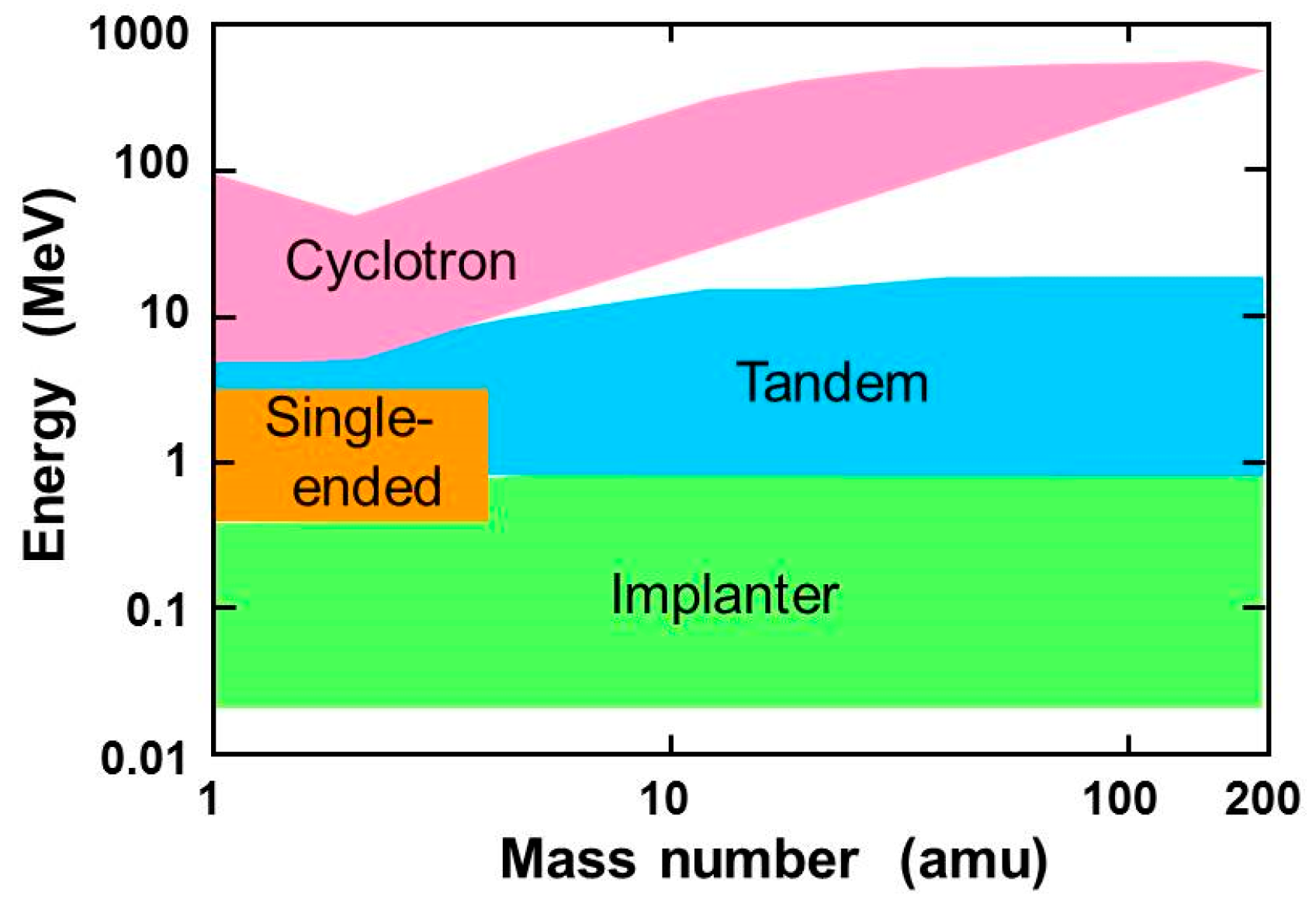
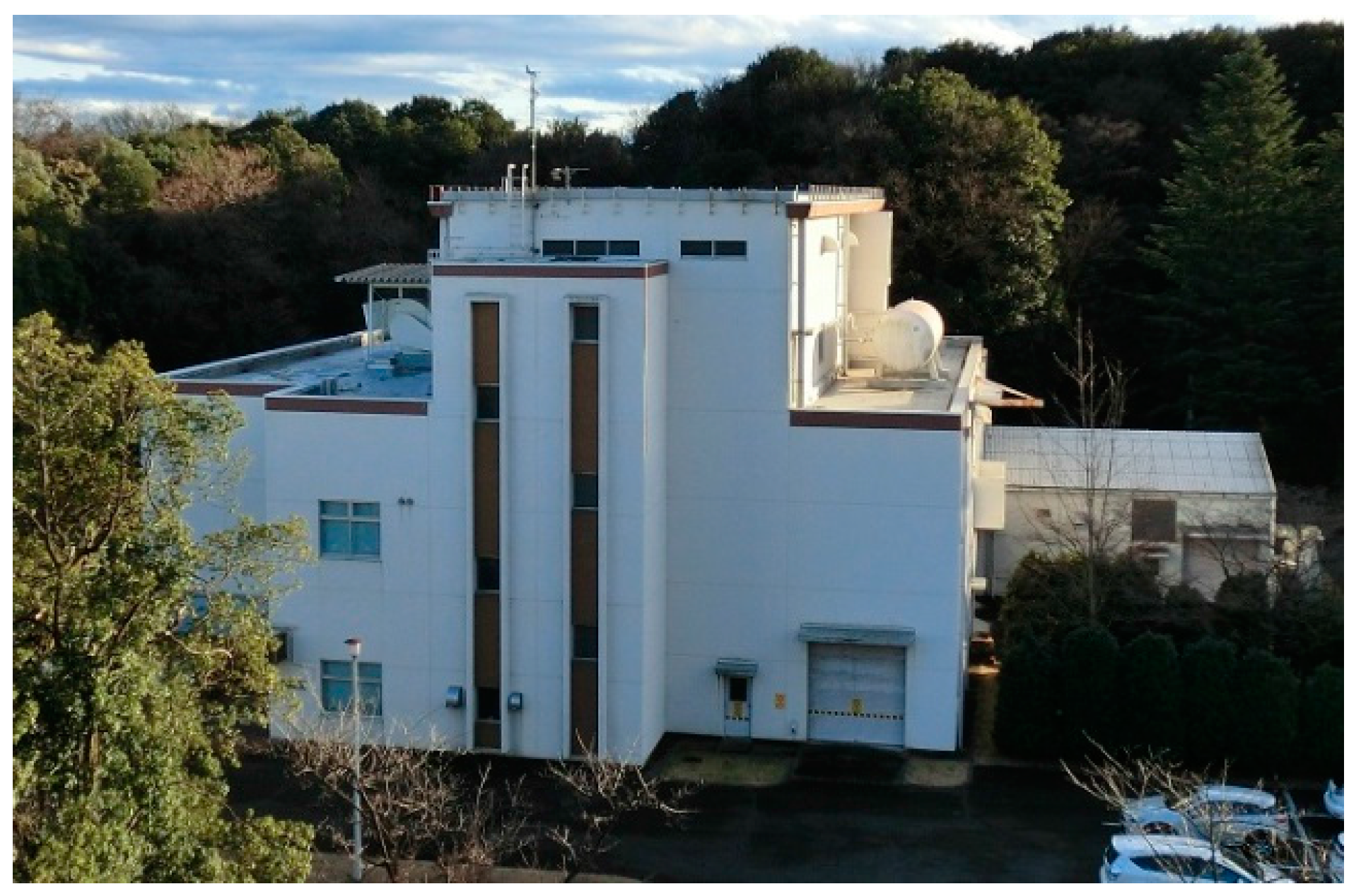

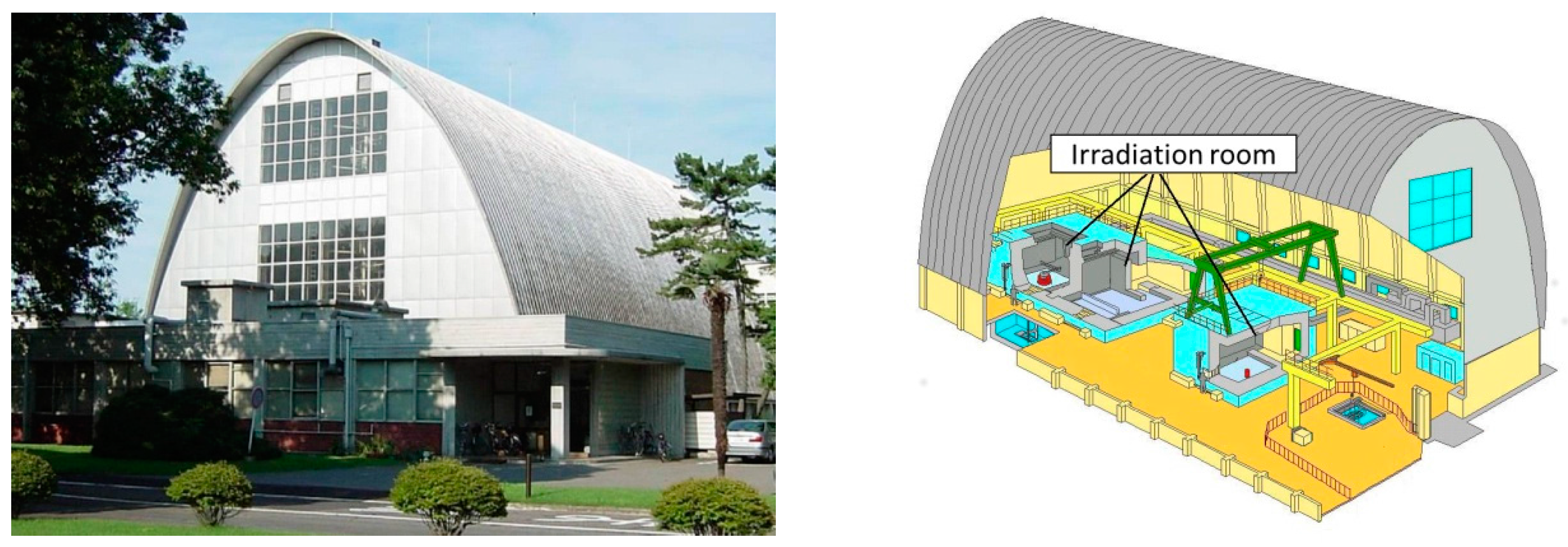
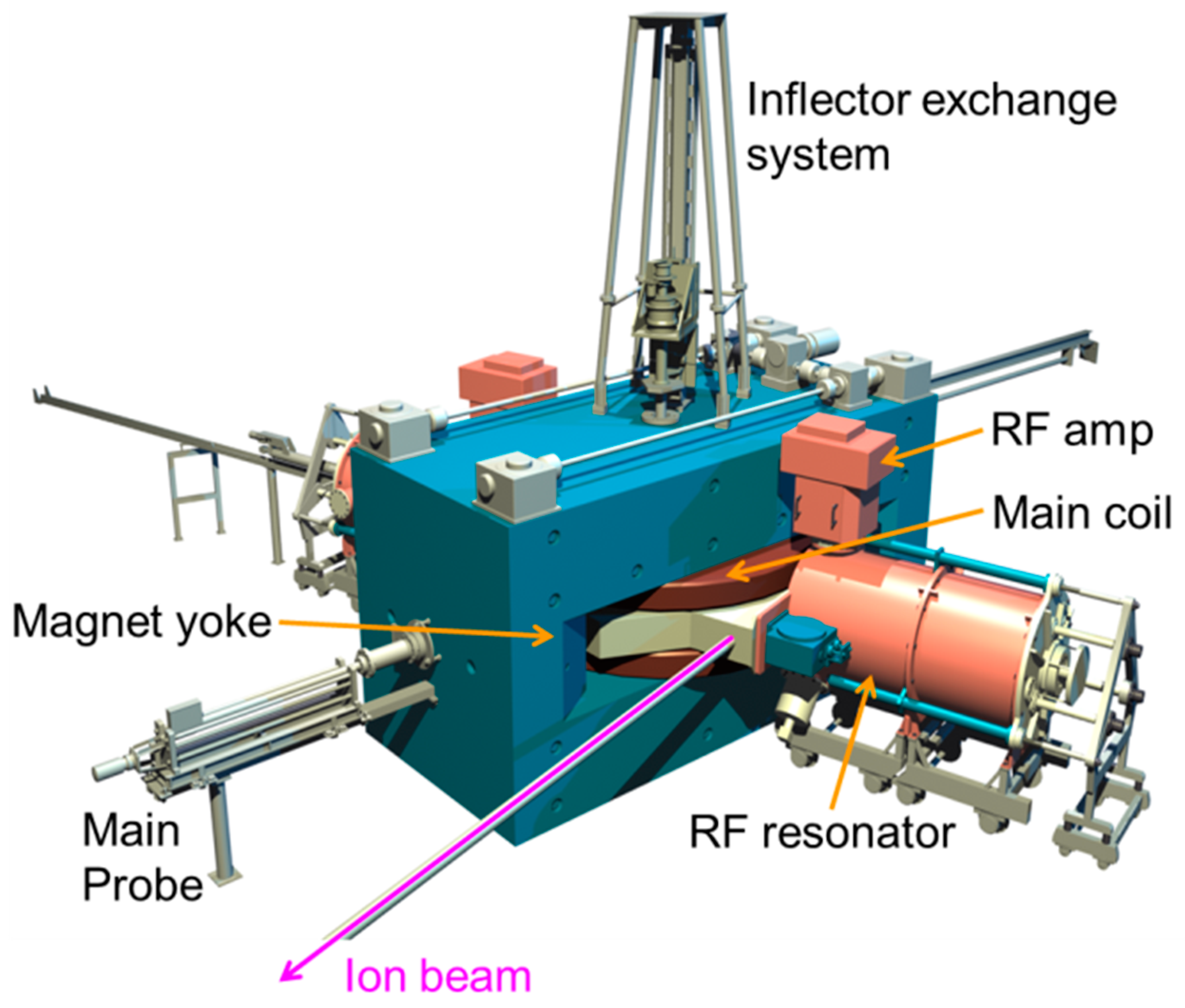
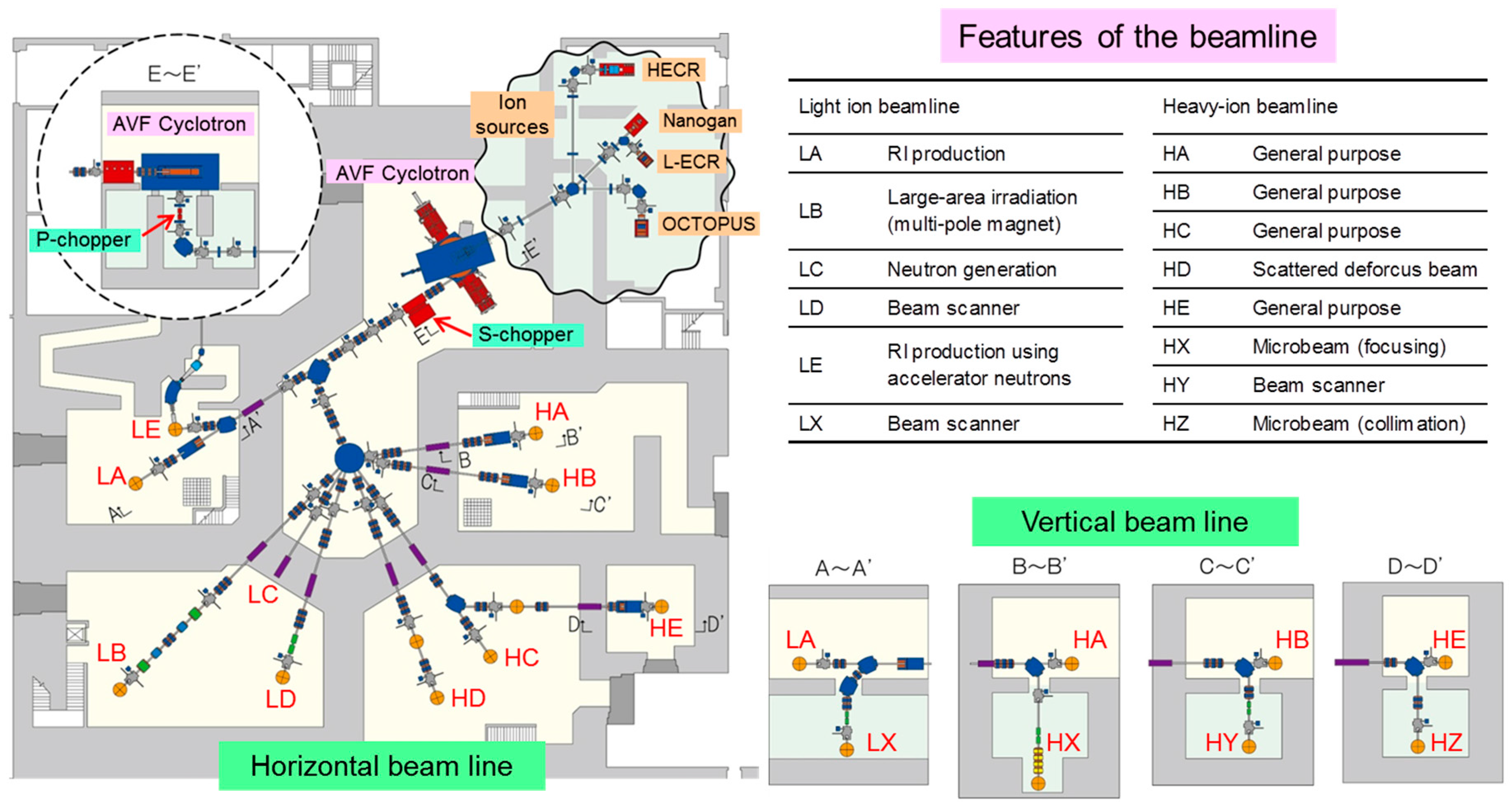
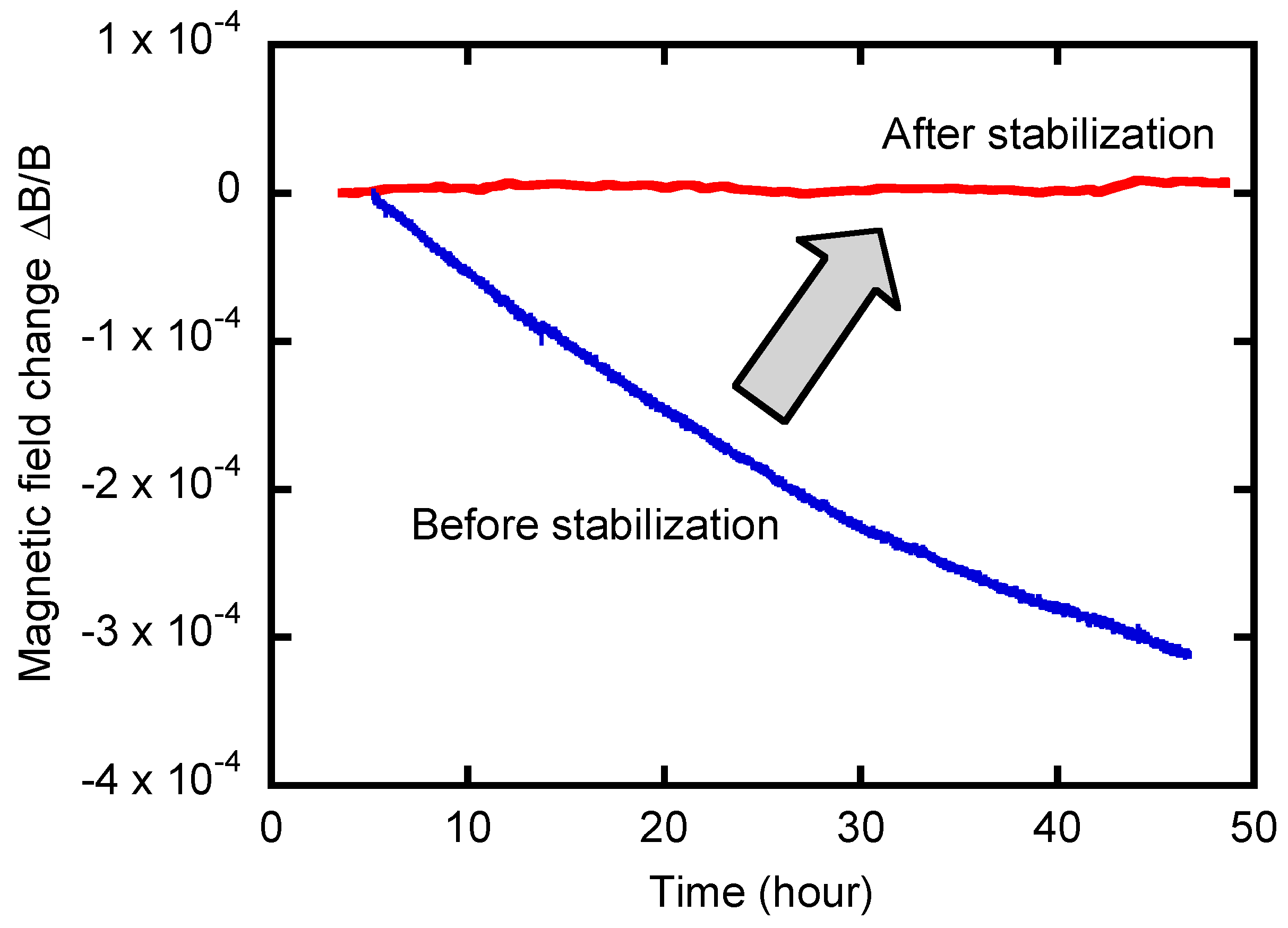
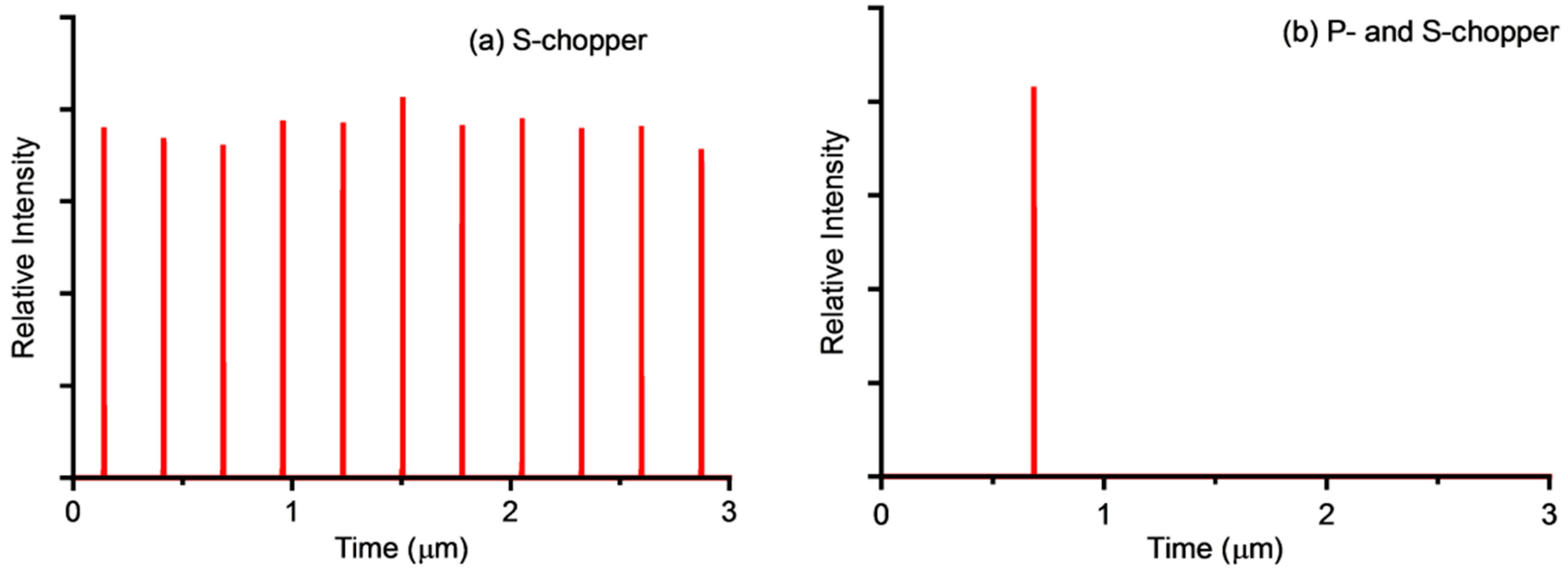

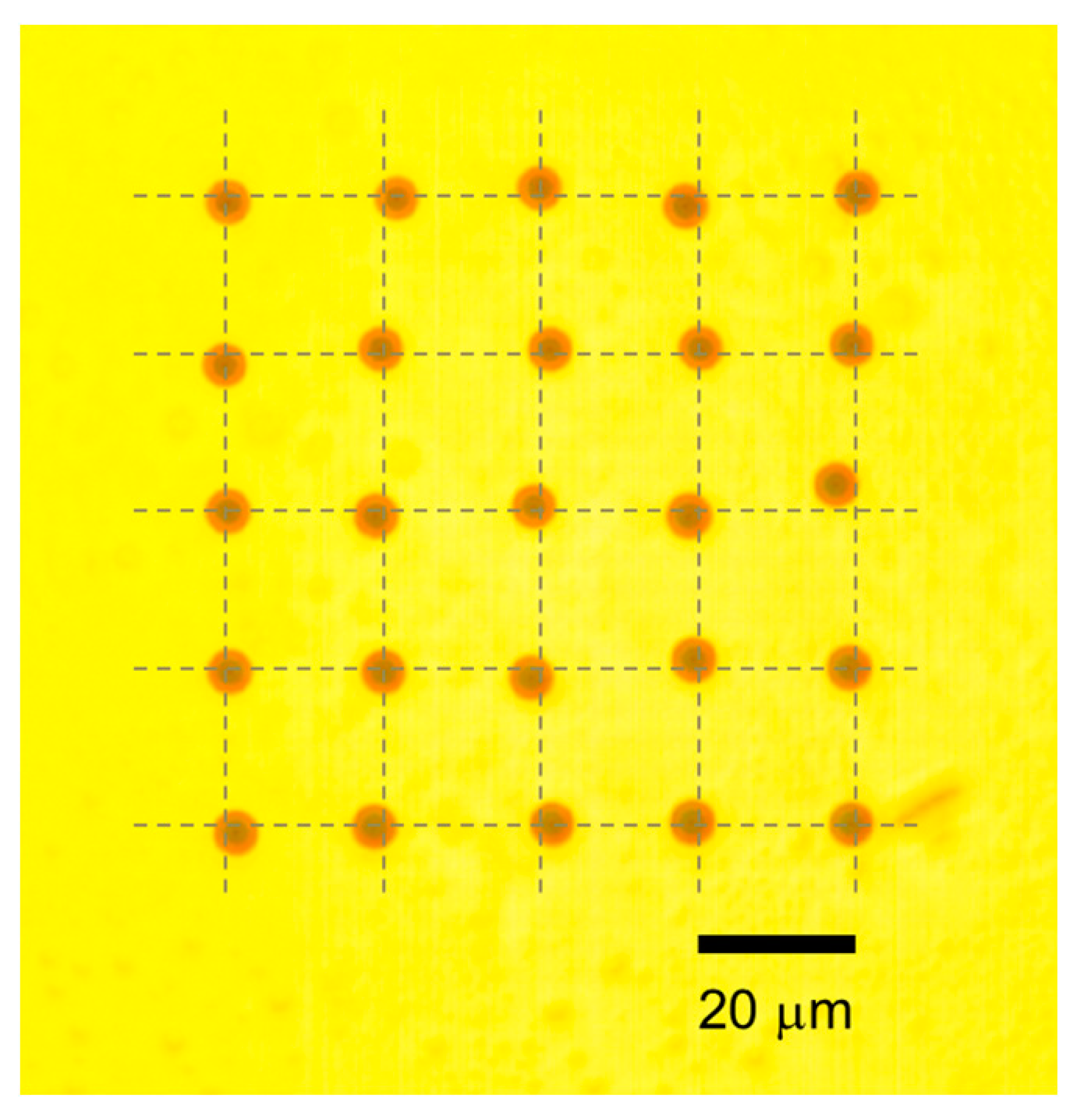

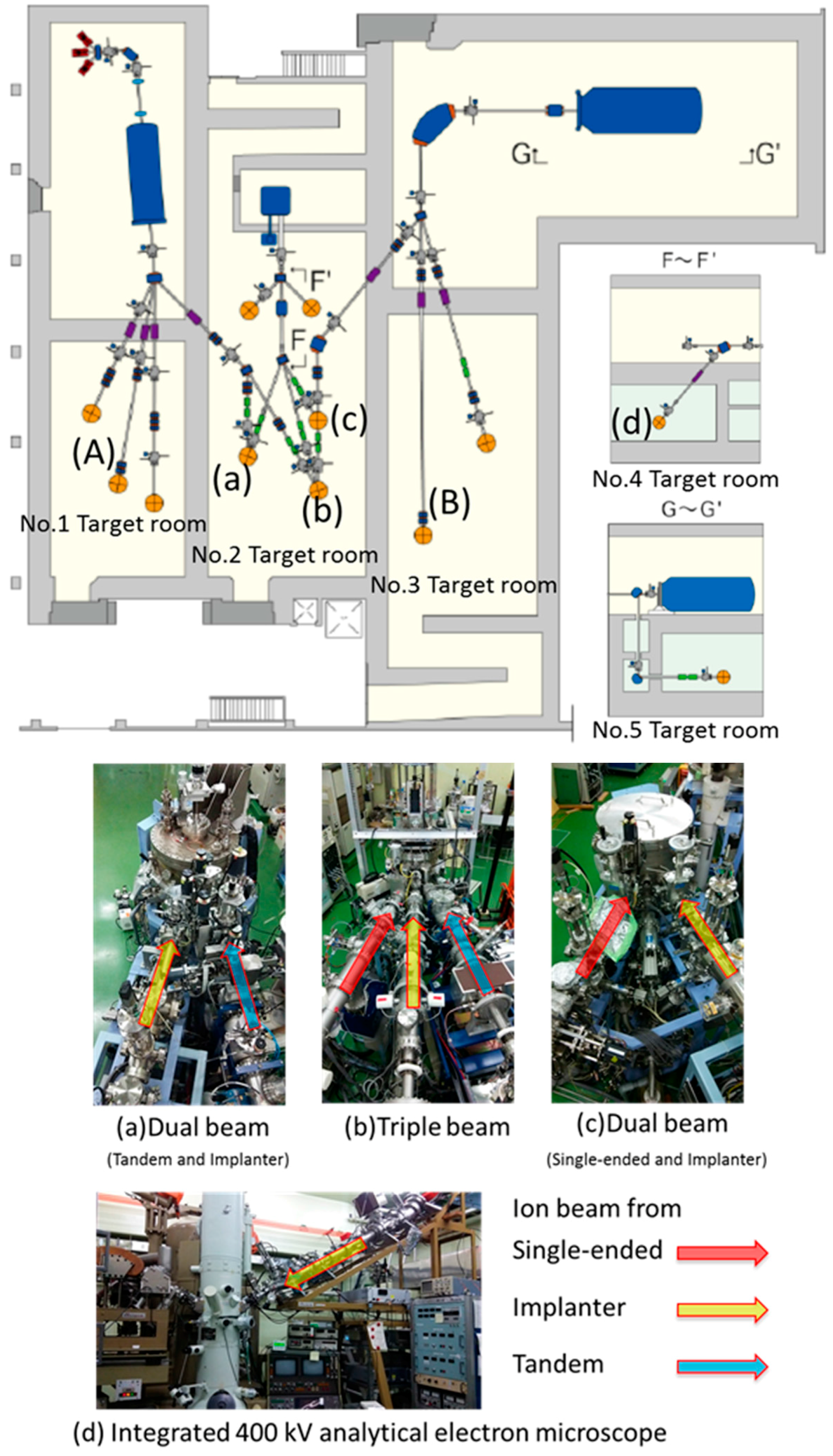
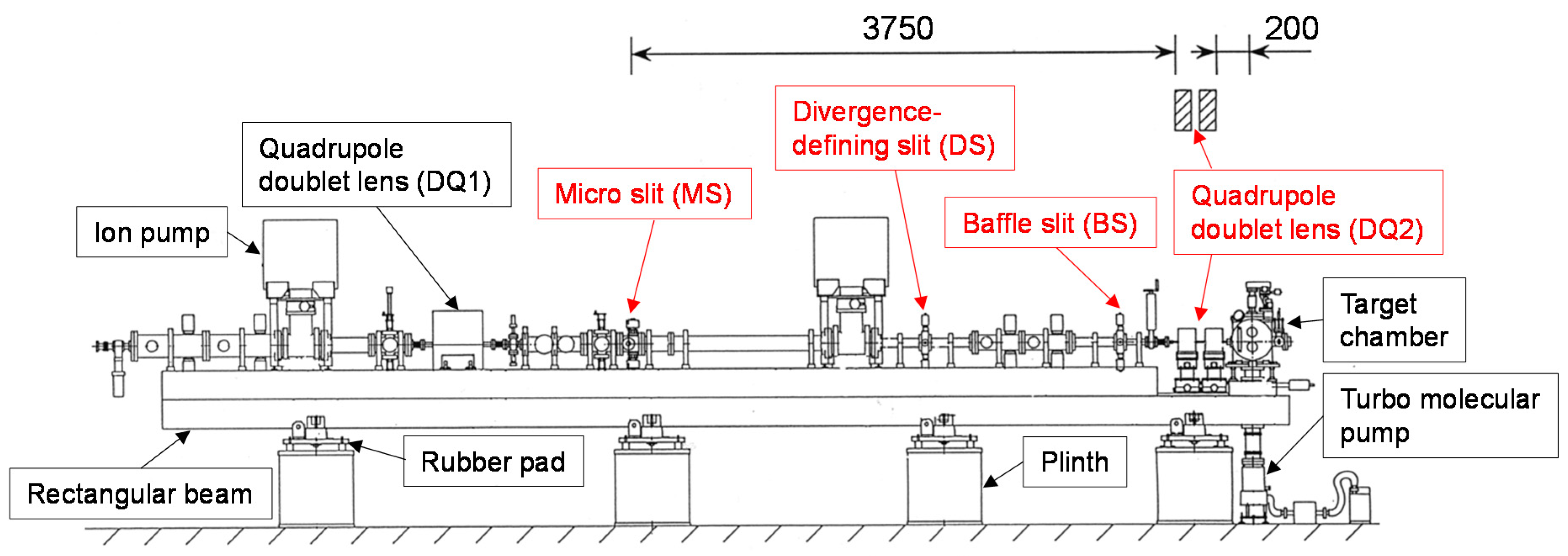
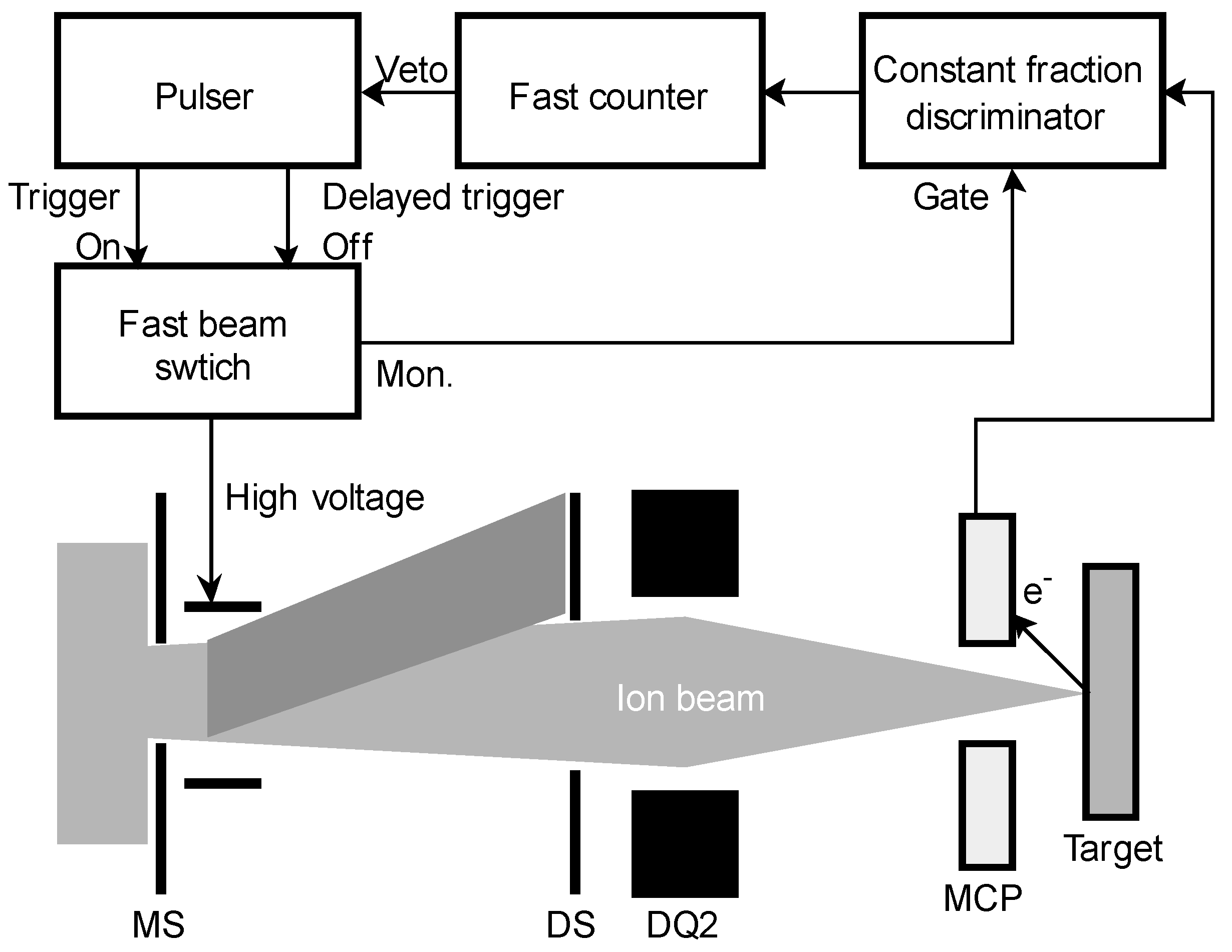
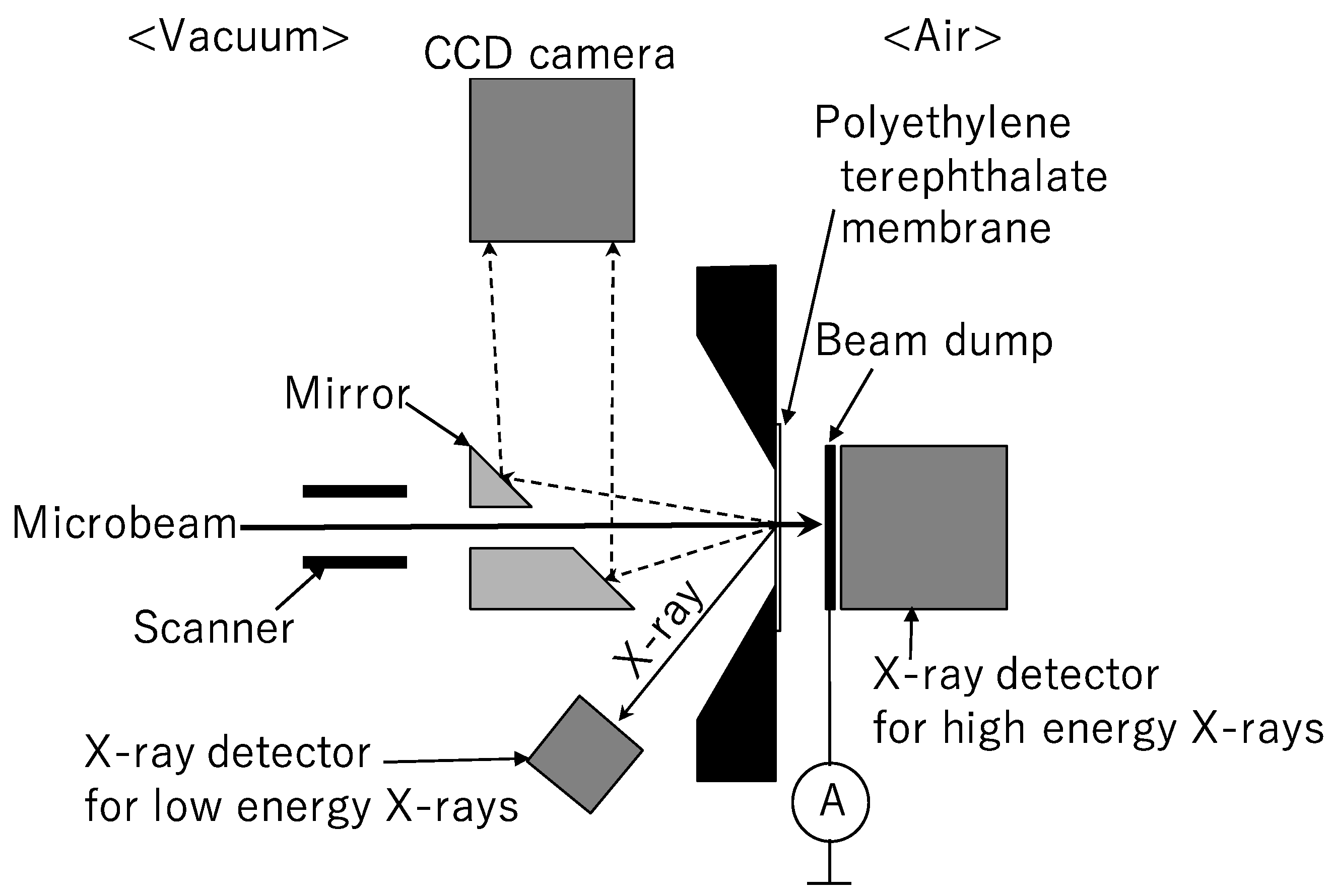
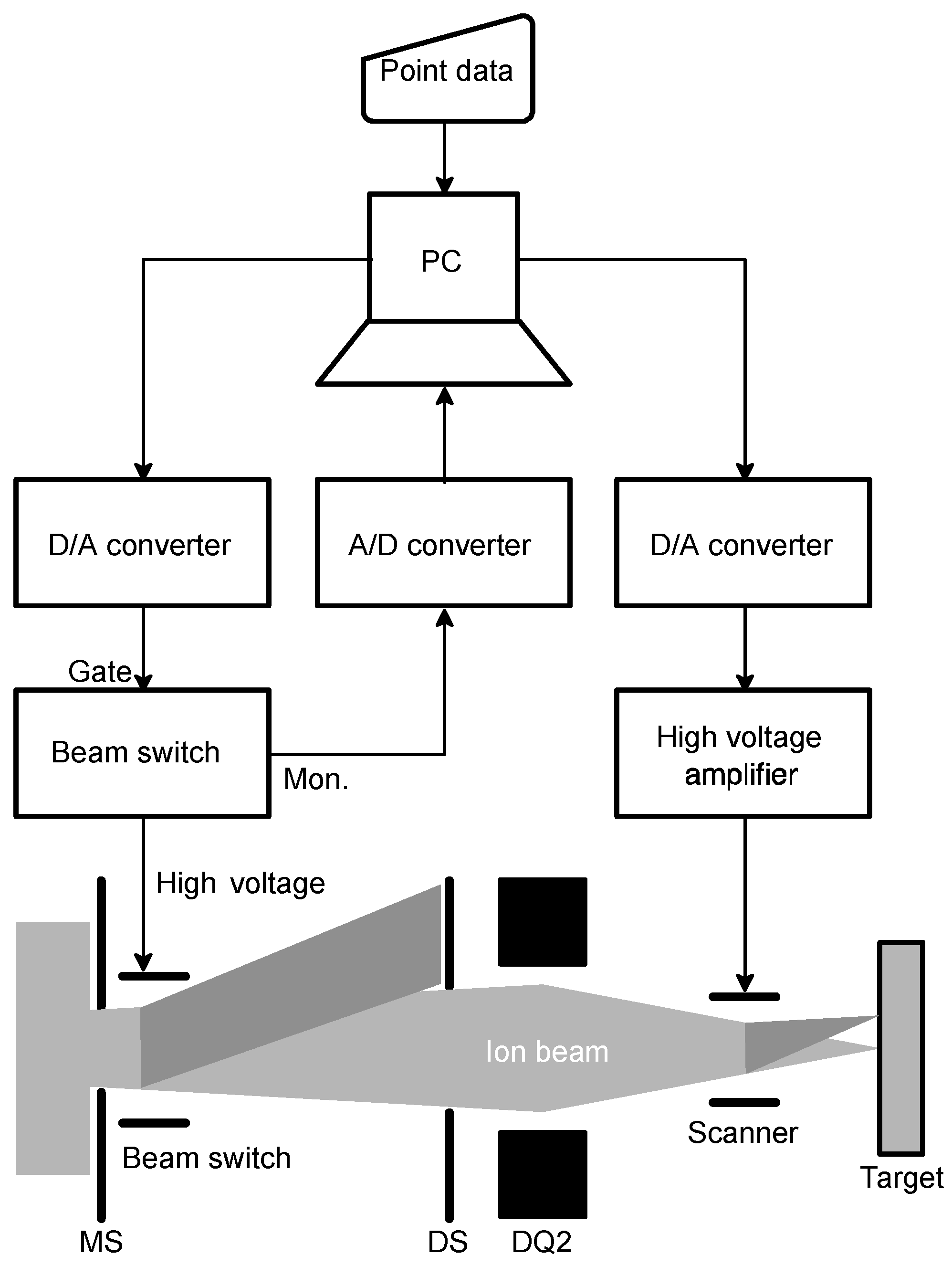
| Item | Specification |
|---|---|
| Bending limit | 110 MeV |
| Focusing limit | 95 MeV |
| Max. average magnetic field | 1.64 T |
| Average extraction radius | 0.923 m |
| Number of sectors | 4 |
| Mass to charge ratio (M/Q) | 1–6.5 |
| Acceleration harmonics | 1, 2, 3 |
| Acceleration frequency | 11–22 MHz |
| Number of dees | 2 |
| Dee apan angle | 86 deg. |
| Max. dee voltage | 60 kV |
| Max. RF power | 50 kW |
| Beam injection | Spiral inflector |
| Beam extraction | Electrostatic deflector |
| Magnetic channel | |
| Gradient corrector |
| Microwave (GHz) | Magnet | Use | Maker | |
|---|---|---|---|---|
| OCTOPUS | 6.4/14.3 | Electrical | Cocktail beam | IBA* (Belgium) |
| HECR | 14.5 | Electrical | Heavy ions incl. metal | Pantechnik (France) |
| L-ECR | 12 | Parmanent | H+ to oxgen | In-house |
| Nanogan | 10 | Parmanent | H+, D+, and helium | Pantechnik |
| Ion | M/Q | Δ(M/Q)/(M/Q) | RF (MHz) | Energy (MeV/A) | LET* in Si (MeV/(mg/cm2)) | Range in Si (mm) |
|---|---|---|---|---|---|---|
| 15N3+ | 4.9995 | 9.410 × 10−4 | 13.867 | 3.751 | 3.45 | 52.7 |
| 20Ne4+ | 4.9976 | 5.606 × 10−4 | 13.873 | 3.754 | 6.33 | 42.5 |
| 40Ar8+ | 4.9948 | 0 | 13.881 | 3.758 | 15.3 | 39.6 |
| 84Kr17+ | 4.9354 | −1.189 × 10−2 | 14.048 | 3.849 | 40.0 | 40.7 |
| 129Xe25+ | 5.1556 | 3.219 × 10−2 | 13.447 | 3.527 | 69.2 | 38.4 |
| Beamline | Scan Area (mm2) | Frequency X (Hz) | Frequency Y (Hz) |
|---|---|---|---|
| LD (horizontal) | 100 × 100 | 50 | 0.25, 0.5, 1, 2.5 |
| LX (vertical) | 20 × 20 | 50 | 0.5, 1, 2.5, 5 |
| HY (vertical) | 50 × 50 | 50 | 0.5, 1, 2.5, 5 |
| Accelerator | Tandem | Single-Ended | Ion Implanter |
|---|---|---|---|
| Model (maker) | 9SDH-2 (NEC) | NC3000B (NHV) | NH-40SR (NE) |
| Charging system | Pelletron chain | Balanced-Schenkel | Cockcroft-Walton |
| Acceleration voltage (MV) | 0.4–3.0 | 0.4–3.0 | 0.01–0.4 |
| Ion source | ∙ Cs sputter type ∙ Charge exchange type | ∙ RF type | ∙ Freeman type ∙ All parmanent magnet type ECR |
| Typical beam current | C3+ 12 MeV: 10 eμA Ni4+ 15 MeV: 4 eμA Au3+ 12 MeV: 12 eμA C601+ 6 MeV: 30 epA | H+ 3 MeV: 300 eμA He+ 3 MeV: 200 eμA e− 3 MeV: 100 e μ A | P1+ 380 keV: 100 eμA Ag1+ 380 keV: 20 eμA C601+ 360 keV: 100 enA Ar3+ 1000 keV: 17 eμA |
© 2017 by the authors. Licensee MDPI, Basel, Switzerland. This article is an open access article distributed under the terms and conditions of the Creative Commons Attribution (CC BY) license ( http://creativecommons.org/licenses/by/4.0/).
Share and Cite
Kurashima, S.; Satoh, T.; Saitoh, Y.; Yokota, W. Irradiation Facilities of the Takasaki Advanced Radiation Research Institute. Quantum Beam Sci. 2017, 1, 2. https://doi.org/10.3390/qubs1010002
Kurashima S, Satoh T, Saitoh Y, Yokota W. Irradiation Facilities of the Takasaki Advanced Radiation Research Institute. Quantum Beam Science. 2017; 1(1):2. https://doi.org/10.3390/qubs1010002
Chicago/Turabian StyleKurashima, Satoshi, Takahiro Satoh, Yuichi Saitoh, and Watalu Yokota. 2017. "Irradiation Facilities of the Takasaki Advanced Radiation Research Institute" Quantum Beam Science 1, no. 1: 2. https://doi.org/10.3390/qubs1010002
APA StyleKurashima, S., Satoh, T., Saitoh, Y., & Yokota, W. (2017). Irradiation Facilities of the Takasaki Advanced Radiation Research Institute. Quantum Beam Science, 1(1), 2. https://doi.org/10.3390/qubs1010002





